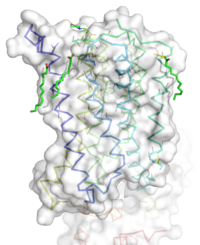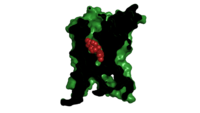Sandbox Reserved 1160
From Proteopedia
(Difference between revisions)
| Line 4: | Line 4: | ||
== Discovery == | == Discovery == | ||
| - | The mGlu family of receptors was the first of the Class C GPCR to be extensively studied<ref name="Wu" />. The first regions of the protein crystallized and studied were the Venus fly trap domain and the cystiene-rich domain on the extracellular region of the receptor. The hydrophobic nature and flexibility of the transmembrane domain made it difficult to crystallize. Recently, the human metabotropic glutamate receptor 5 transmembrane domain was crystallized and a structure elucidated. There were several modifications that had to be made to the TMD for it to successfully crystallize. The protein was thermostabilized and flexible domains were removed. In total residue 2-568 and residues 837-1153 were excised from the structure. Also, a T4 -<scene name='72/721531/Protien_lys/1'>Lysozyme</scene> was inserted into ICL-2. | + | The mGlu family of receptors was the first of the Class C GPCR to be extensively studied<ref name="Wu" />. The first regions of the protein crystallized and studied were the Venus fly trap domain and the cystiene-rich domain on the extracellular region of the receptor<ref name="Dore" />. The hydrophobic nature and flexibility of the transmembrane domain made it difficult to crystallize. Recently, the human metabotropic glutamate receptor 5 transmembrane domain was crystallized and a structure elucidated<ref name="Dore" />. There were several modifications that had to be made to the TMD for it to successfully crystallize. The protein was thermostabilized and flexible domains were removed<ref name="Dore" />. In total residue 2-568 and residues 837-1153 were excised from the structure. Also, a T4 -<scene name='72/721531/Protien_lys/1'>Lysozyme</scene> was inserted into ICL-2<ref name="Dore" />. |
== Structure== | == Structure== | ||
[[Image:STR.png|200 px|left|thumb|Overall Structure of the TMD. The polar heads on the Oliec acids orient the protein with the top of the image being the extracellular portion of the protein,the middle portion inserted into the membrane, and the lower portion located inside of the cell. ]] | [[Image:STR.png|200 px|left|thumb|Overall Structure of the TMD. The polar heads on the Oliec acids orient the protein with the top of the image being the extracellular portion of the protein,the middle portion inserted into the membrane, and the lower portion located inside of the cell. ]] | ||
| Line 12: | Line 12: | ||
This is the <scene name='72/721532/Ecl_trail_1/7'>Extracellular Loops</scene> shows the extracellular loops (ECL) 1, 2, and 3 highlighted in purple. Additionally in the ECL domain, a <scene name='72/721532/Ecl_trail_1/6'>Disulfide Bond</scene> is attached to Helix 3 and the Amino Acid chain between Helix 5 and the N terminus. The disulfide bond is highlighted in yellow, and it is conserved in all classes of glutamate receptor 5 transmembrane domains. | This is the <scene name='72/721532/Ecl_trail_1/7'>Extracellular Loops</scene> shows the extracellular loops (ECL) 1, 2, and 3 highlighted in purple. Additionally in the ECL domain, a <scene name='72/721532/Ecl_trail_1/6'>Disulfide Bond</scene> is attached to Helix 3 and the Amino Acid chain between Helix 5 and the N terminus. The disulfide bond is highlighted in yellow, and it is conserved in all classes of glutamate receptor 5 transmembrane domains. | ||
=== Binding Pocket === | === Binding Pocket === | ||
| - | [[Image: Organic with clipped surface.png| | + | [[Image: Organic with clipped surface.png|200 px|left|thumb|Cross section view of mavoglurant in the binding pocket]] |
| - | The binding pocket represents an interesting source of regulatory control of receptor activity. The binding pocket is only accessible by a relatively narrow (7 angstrom) <scene name='72/721531/Protien_sur/4'>entrance</scene><ref name="Dore" />. This small entrance severely restricts the access of both positive and negative allosteric regulators. This structural feature will severely limit the size of possible regulators. | + | The binding pocket represents an interesting source of regulatory control of receptor activity. The binding pocket is only accessible by a relatively narrow (7 angstrom) <scene name='72/721531/Protien_sur/4'>entrance</scene><ref name="Dore" />. This small entrance severely restricts the access of both positive and negative allosteric regulators. This structural feature will severely limit the size of possible regulators. |
| + | |||
Important Amino Acids<ref name="Dore" />: | Important Amino Acids<ref name="Dore" />: | ||
*<scene name='72/721531/Protien_bindtop/4'>Asparagine</scene> 747forms a hydrogen bond network with the main chain carbonyl of Glycine 652 and the carbamate portion of mavoglurant. | *<scene name='72/721531/Protien_bindtop/4'>Asparagine</scene> 747forms a hydrogen bond network with the main chain carbonyl of Glycine 652 and the carbamate portion of mavoglurant. | ||
| Line 20: | Line 21: | ||
*A <scene name='72/721531/Protien_bindbottom/1'>water molecular</scene> inside of the binding pocket helps stabilize the inactive state. | *A <scene name='72/721531/Protien_bindbottom/1'>water molecular</scene> inside of the binding pocket helps stabilize the inactive state. | ||
| - | Once bound to mavoglurant, transmembrane helix 7 undergoes a conformational change<ref name="Dore" />. The shifting of TM7 will lead to a more global conformational change, which we leave the receptor incapable of signaling<ref name="Dore" />. | + | Once bound to mavoglurant, transmembrane helix 7 undergoes a conformational change<ref name="Dore" />. The shifting of TM7 will lead to a more global conformational change, which we leave the receptor incapable of signaling<ref name="Dore" />.Variation can be seen in positioning of alpha helices. Class C receptors has seemingly less space for [https://fragilex.org/2014/research/news-reports-and-commentaries/novartis-announces-results-of-mavoglurant-mglur5-afq056-clinical-trials-and-the-conclusion-of-the-long-term-extension-study/ mavoglurant] to enter compared to Class A and F<ref name="Wu" />. The ligand binding site is also varied between different classes of mGlu receptors<ref name="Dore" />. |
=== Ionic Locks === | === Ionic Locks === | ||
| Line 26: | Line 27: | ||
== Function and Pathway == | == Function and Pathway == | ||
| - | It all begins with glutamate binding to the venus fly trap domain. The signal transduction goes across the cystine-rich domain to the TMD. Next the dimerization of the TMD occurs. This activates the Gq/11 pathway, which activates phspholipase Cβ. The active phospholipase Cβ performs hydrolysis on phosphotinositides and generates inositol 1,4,5-trisphosphate and diacyl-glycerol. This results in calcium mobilization and activation of protein kinase C. | + | It all begins with glutamate binding to the venus fly trap domain. The signal transduction goes across the cystine-rich domain to the TMD. Next the dimerization of the TMD occurs. This activates the Gq/11 pathway, which activates phspholipase Cβ. The active phospholipase Cβ performs hydrolysis on phosphotinositides and generates inositol 1,4,5-trisphosphate and diacyl-glycerol. This results in calcium mobilization and activation of protein kinase C<ref name="Niswender" />. |
| - | + | ||
== Disease == | == Disease == | ||
=== Fragile X === | === Fragile X === | ||
Fragile X syndrome is the most common genetic cause of mental disabilty, and is a member of the Autism spectrum disorder family<ref name="Bailey" />. The severity of intellectual disability can vary from patient to patient, but symptoms stem from a misregulation of the mGlu1 and MGlu5 pathways<ref name="Bailey" />. This leads to over potentiation in neural cells. Mavoglurant and other allosteric regulators like fenobam have shown promise in treating Fragile X.One positive characteristic of ligands that target the TMD is they tend to be more specific, thus interacting less with brain proteins<ref name="Feng" />. Mavoglurant would act to down regulate glutamate signaling in an attempt to decrease potentiation. Unfortunately, recent Phase 2 clinical trials have proven mavoglurant ineffective <ref name="Bailey" />. Novartis the company who developed the drug has stopped clinical trials of mavoglurant <ref name="Bailey" />. However, modulators of mGlu5 TMD are still be researched to treat Parkinson's, Alzheimer's disease, and various addictions<ref name="Niswender" />. | Fragile X syndrome is the most common genetic cause of mental disabilty, and is a member of the Autism spectrum disorder family<ref name="Bailey" />. The severity of intellectual disability can vary from patient to patient, but symptoms stem from a misregulation of the mGlu1 and MGlu5 pathways<ref name="Bailey" />. This leads to over potentiation in neural cells. Mavoglurant and other allosteric regulators like fenobam have shown promise in treating Fragile X.One positive characteristic of ligands that target the TMD is they tend to be more specific, thus interacting less with brain proteins<ref name="Feng" />. Mavoglurant would act to down regulate glutamate signaling in an attempt to decrease potentiation. Unfortunately, recent Phase 2 clinical trials have proven mavoglurant ineffective <ref name="Bailey" />. Novartis the company who developed the drug has stopped clinical trials of mavoglurant <ref name="Bailey" />. However, modulators of mGlu5 TMD are still be researched to treat Parkinson's, Alzheimer's disease, and various addictions<ref name="Niswender" />. | ||
| - | + | ||
== References == | == References == | ||
Revision as of 11:04, 30 March 2016
Human metabotropic glutamate receptor 5 transmembrane domain
| |||||||||||


